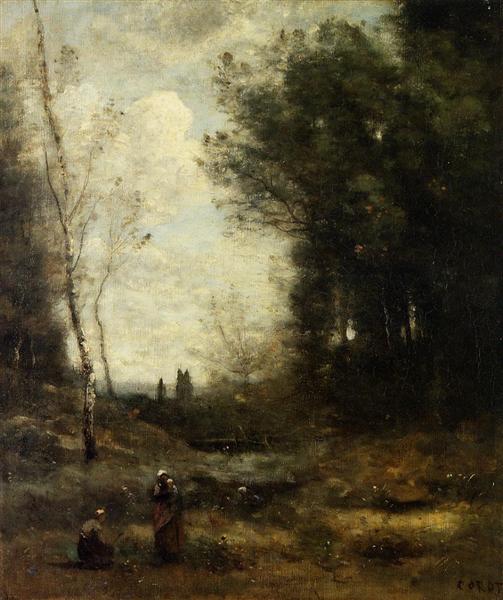Description
L'œuvre "El Valle", peinte par Camille Corot en 1871, est une représentation évocatrice de la nature qui reflète à la fois la maîtrise technique de l'artiste et son lien profond avec les paysages qu'il a choisis de représenter tout au long de sa carrière. Cette image est un témoignage supplémentaire de l'engagement de Corot envers le réalisme poétique et l'approche lyrique du paysage, un mouvement qui le positionne comme une figure clé de la transition vers l'impressionnisme.
Lors de l'observation de "El Valle", on fait face à une composition qui rayonne une sérénité presque idyllique. L'œuvre présente un paysage typique du style de Corot, qui trouve l'équilibre parfait entre la composition artistique naturellement planifiée et la composition artistique. L'utilisation de Chiaroscuro démontre son domaine dans la représentation de la lumière et de l'ombre, donnant aux éléments de la peinture une profondeur à trois dimensions qui semble inviter le spectateur à entrer dans la scène. Le bosquet se déroule doucement dans le plan du milieu, où l'on peut voir la texture du feuillage; Le vert, dans les variations de tons mous qui varient entre le vibrant et le désactivé, suggèrent le passage du temps et l'influence du climat.
La palette de couleurs de Corot dans cette œuvre est riche et nuancée, mettant l'accent sur l'utilisation de tons de terre qui prédominent dans le paysage, contrasté par la luminosité du ciel. Ce ciel, un mélange de bleu bleu et de nuages, suggère à la fois une journée claire et une atmosphère de contemplation tranquille. En arrière-plan, les collines s'étendent dans des lignes attrayantes qui semblent dessiner l'horizon, offrant un sentiment d'immensité au paysage.
Une caractéristique notable de la "vallée" est l'absence de figures humaines, une décision qui renforce l'idée d'un monde naturel pur, isolé de l'intervention de l'être humain. Le lien entre l'homme et la nature est un thème récurrent dans le travail de Corot, et lors du choix de ne pas inclure de personnages, il permet au paysage de se rendre à la vie. Cette absence ne ressemble pas à un manque, mais en tant que libération qui élargit l'interprétation de la place et de l'expérience personnelle du spectateur. Dans ce travail, la nature devient le sujet principal, une toile dans laquelle l'expérience humaine peut se refléter dans son intégralité.
Le contexte historique de cette peinture est à une époque où l'art a commencé à remettre en question la rigueur de l'académicisme et à explorer de nouvelles façons de capturer l'essence du monde environnant. Corot, avec son approche basée sur l'observation de la nature, a jeté les fondements des futurs courants artistiques. Son influence est palpable dans l'œuvre de nombreux artistes ultérieurs qui ont cherché à capturer la lumière et la couleur de la manière la plus authentique possible.
"The Valley" s'aligne avec d'autres œuvres de corot qui explorent également le paysage idéalisé et la connexion spirituelle avec la nature, comme "le paysage d'Oise" et "Vista de Tivoli". Dans chacune de ces œuvres, Corot reflète son dévouement à la lumière naturelle et ses effets sur la perception visuelle, des aspects qui deviennent fondamentaux dans le développement de l'impressionnisme.
Ainsi, l'œuvre capture non seulement un moment dans le temps, mais invite également la réflexion sur notre relation avec l'environnement. Le délicat coup de pinceau et la conscience des couleurs obtiennent le spectateur non seulement d'observer, mais aussi de ressentir le calme qui émane de cette vallée, un rappel de la beauté qui réside dans la simplicité de la nature. En bref, "El Valle" est une œuvre qui transcende son propre temps, montrant la maîtrise de Camille Corot et sa capacité à relier le monde naturel à l'expérience humaine de manière poétique et profonde.
KUADROS ©, une peinture célèbre sur votre mur.
Peintures à l'huile fabriquées à la main, avec la qualité des artistes professionnels et le sceau distinctif de KUADROS ©.
Service de reproduction des images avec garantie de satisfaction. Si vous n'êtes pas complètement satisfait de la réplique de votre peinture, nous remboursons votre argent à 100%.

